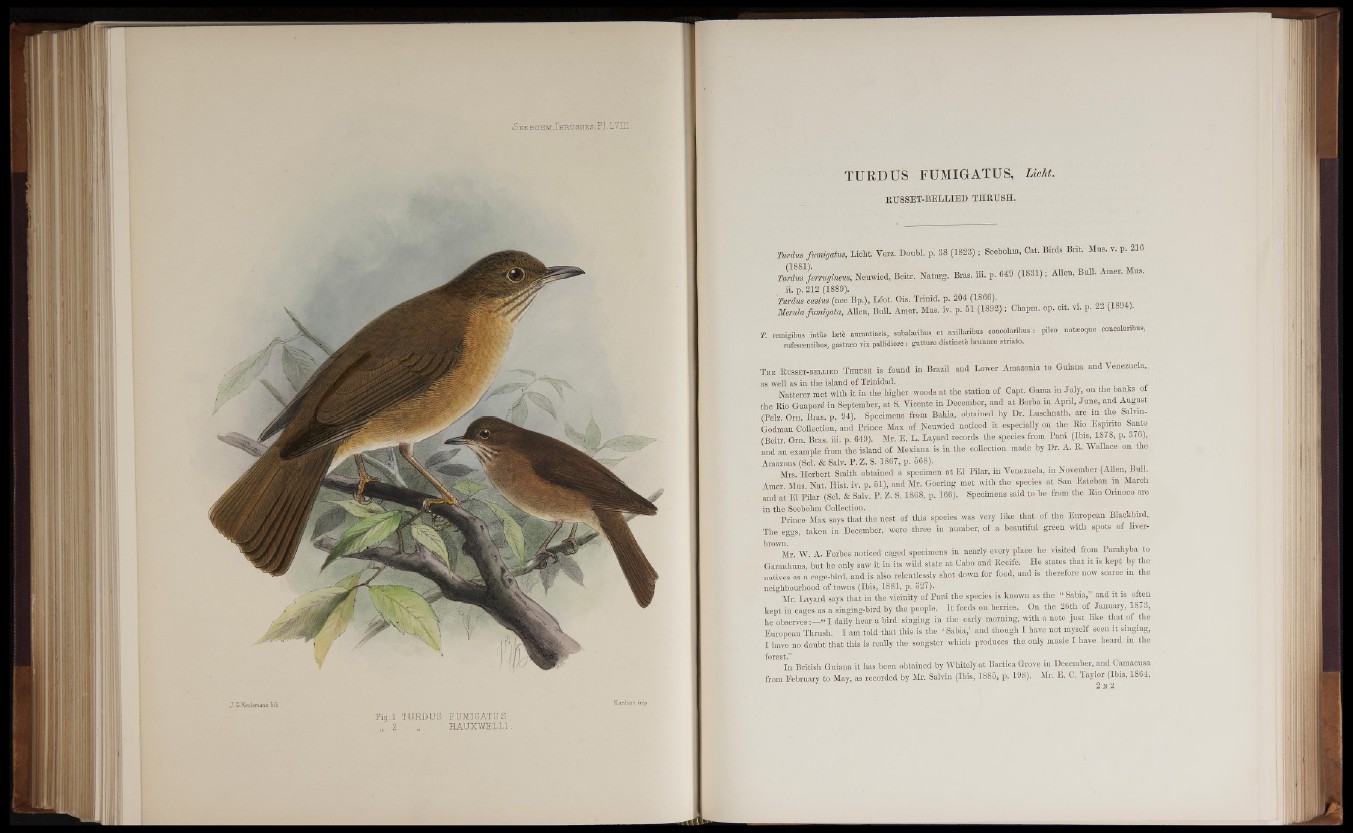
J. C.Keulemans Ktn.
T ig . 1 THRDUS TUM'IGATU S
„ 2 .* • „ HAUXWELLI
Hanha rt unp.
TURD US FUMIGrATUS, LicM.
RUSSET-BELLIED THRUSH.
Turdus fumigatus, Licht. Verz. Doubl, p. 38 (1823) ; Seebohm, Cat. Birds Brit. Mus. y. p. 216
M w ferrugineus, Neuwied, Beitr. Naturg. Bras. iii. p. 649 (1831); Allen, Bull. Amer. Mus.
ii. p . 212 (1889).
Turdus casius (nec Bp.), Leot. Ois. Trinid. p. 204 (1866). .
Merula fumigata, Allen, Bull: Amer. Mus. iv. p. 51 (1892); Chapm. op. cit. vi. p. 22 (189 ).
T. remigibus intus kete aurantiacis, subalaribus et axillaribus oonooloribus : pileo notsoqUe coneoloribus,
rufescentibus, g a s ta o vix pallidiore : gutture distincte brunneo striato.
T he R usset-bellied T hkush is found in Brazil and Lower Amazonia to Guiana and Venezuela,
as well as in the island of Trinidad. . f
Natterer met with it in the higher woods at the station of Capt. Gama in July, on the banks oi
the Bio Guapore in September, at S. Vicente in December, and at Borba in April, June, and August
(Pelz. Orn. Bras. p. 94). Specimens from Bahia, obtained by Dr. Luschnath, are in the Salvm-
Godman Collection, and Prince Max of Neuwied noticed it especially on the Bio Espirito Santo
(Beitr. Om. Bras. iii. p. 649). Mr. E. L. Layard records the species from Para (Ibis, 1878, p. 376),
and an example from the island of Mexiana is in the collection made by Dr. A. E. Wallace on the
Amazons (Scl. & Salv. P. Z. S. 1867, p. 568fe|^,;V; ; -
Mrs. Herbert: Smith obtained a specimen at E l Pilar, in Venezuela, in November (Allen, Bull.
Amer. Mus. Nat. Hist. iv. p. 51), and Mr. Goering met with the species at San Esteban in March
and at El Pilar (Scl. & Salv. P. Z. S. 1868, p, 166). Specimens said to be from the Bio Orinoco are
in the Seebohm Collection. _ , 7
Prince Max says that the nest of this species was very like that of the European Blackbird.
The eggs, taken in December, were three in number, of a beautiful green with spots of liver-
brown.
Mr W A. Porbes noticed caged specimens in nearly every place he visited- from Parahyba to
Garanhuns, but he only saw it in its wild state at Cabo and Eecife. He states that it is kept by the
natives as a cage-bird, and is also relentlessly shot down for food, and is therefore now scarce in the
neighbourhood of towns (Ibis, 1881, p. 327). -
Mr. Layard says that in the vicinity of Para the species is known as the “ Sabia,” and it is often
kept in cages as a singing-bird by the people. It feeds on berries. On the 26th of January, 1873,
he o b s e r v e s “ I daily hear a bird singing in the early morning, with a note just like that of the
European Thrush. I am told that this is the ‘ Sabia,’ and though I have not myself seen it singing,
I have no doubt that this is really the songster which produces the only music I have heard in the
forest.” r,
In British Guiana it has been obtained by Whitely at Bartica Grove in December, and Camacusa
from February to May, as recorded by Mr. Salvin (Ibis, 1885, p. 198). Mr. E. C. Taylor (Ibis, 1864,
2 N 2